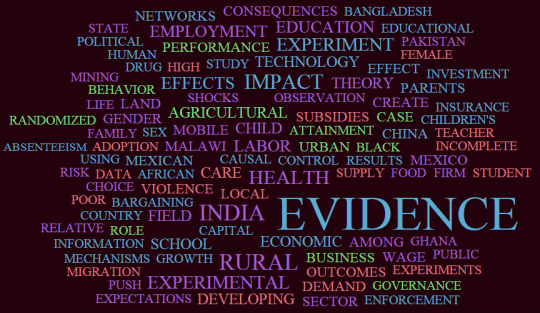I returned last week from the
2014 Pacific Conference for Development Economics, with 80 presentations over the course of a very full day. These conferences are a great way to see what research is coming down the line across a whole array of topics (see below the word cloud generated from the presentation titles).


Here is a run-down of some of the evaluations presented, each in one tweet or less! (The papers are grouped into a single PDF per session, so search or scroll within the link.)
Cash transfers!
Note on the word cloud: Someone could (or has) written a thesis on word choices in titles. Across these titles, “evidence” wins, followed by “rural,” “India,” “impact,” “health,” “experiment,” and “experimental.” (I used textalyser.net for the analysis, and WordItOut.com to generate the word cloud.)
Cash transfers!
- Cash transfers to moms (vs household head) in Macedonia improves secondary school enrollment only for kids already expected to do well. (Armand)
- Conditional cash transfers in India increased supply of health care but not quality! (Triyana)
- Cash transfers in Mexico hurt ineligible households in the same neighborhood: Higher prices outweigh higher wages (Lehmann)
- Providing accurate info about children’s academic abilities to parents in Malawi significantly affects investments (Dizon-Ross)
- Teacher hardship allowance in the Gambia gets more teachers to hardship schools but doesn’t seem to improve education for the average student. (Pugatch & Schroeder)
- Armed conflict in Punjab was bad for education (?!). Particularly bad for girls. (Singh & Shemyakina)
- Want to improve educational outcomes and spending on children of HIV+ individuals in Malawi? Treat their parents! (Baranov & Kohler)
- Giving textbooks to schools in Sierra Leone doesn’t help students learn if students never get them (Sabarwal et al)
- DVD lectures used for college prep in Bangladesh significantly increased university admission (Kono et al)
- Nationally representative panel data in India shows that absence hasn’t gotten better, but inspections really reduce them (Muralidharan et al)
- The switch from English to Bahasa Malaysia as the language of instruction in Malaysia in 1970s improved schooling and wages (but not literacy) for some (del Carpio et al)
- Smart phone monitoring improved health inspectors’ performance most acutely for inspectors with great personalities (Big 5 personality traits) (Callen et al)
- High absolute incentives for reducing malnutrition in daycare centers in India worked, but mostly for boys and for kids whose religion is the same as the worker (Singh & Mitra)
- Rapid diagnostic tests for malaria, even after patients had bought medicine, dramatically improved compliance. A text msg the next day boosted compliance even more! (Modrek et al)
- Giving a transport subsidy to job seekers for up to 11 weeks in Ethiopia increases the likelihood of finding steady employment by more than a third! (Franklin)
- Vocational training in Turkey had small effects in the first year, but those dissipated by the end of 3 years. (Hirshleifer et al) – co-authored by our own David McKenzie
- Drug violence in Mexico is bad for labor market participation. (Calderón et al)
- Falling maize prices in Mexico meant more drugs and more violence (Dube et al)
- Poll observers in Ghana reduced fraud reduce over-voting at their stations but it gets displaced to unobserved stations (Asunka et al)
- Legal aid in rural Liberia improved satisfaction among plaintiffs, reduced bribes, and improved food security. Get me a quasi-lawyer! (Sandefur & Siddiqi)
- India’s quotas for subsidized cereals improve intake across food groups! (Kaul)
- Rural roads in India increased adoption of agricultural technologies J but also led to school drop-outs to join the labor force L (Aggarwal)
- Mobile money in Uganda has dramatically increased consumption through remittance income. (Munyegera & Matsumoto)
- A one-time fertilizer subsidy in Mozambique leads to persistent impacts on fertilizer use as well as consumption (Carter et al)
- For a commitment savings product in the Philippines, the clients who were more sophisticated about their hyperbolic discounting just avoided the product. (Hofmann)
- Flexible microcredit design in Bangladesh did not result in higher default (as feared), and after the first year seems to increase consumption in the lean season. (Shonchoy & Kurosaki)
- Child sponsorship programs improve not only schooling outcomes, but also educational & vocational aspirations! (Glewwe et al)
- China’s economic liberalization post-Mao doubles rate sex selection toward boys (Almond et al)
- Simons et al use temperature sensors to check for the Hawthorne effect in stove use (per my earlier post). (Big Hawthorne effect uncovered!)
- Dizon-Ross et al use undercover enumerators to hunt for corruption in bednet distribution in Kenya, Uganda, and Ghana. (Little corruption found: yay!)
Note on the word cloud: Someone could (or has) written a thesis on word choices in titles. Across these titles, “evidence” wins, followed by “rural,” “India,” “impact,” “health,” “experiment,” and “experimental.” (I used textalyser.net for the analysis, and WordItOut.com to generate the word cloud.)


Join the Conversation